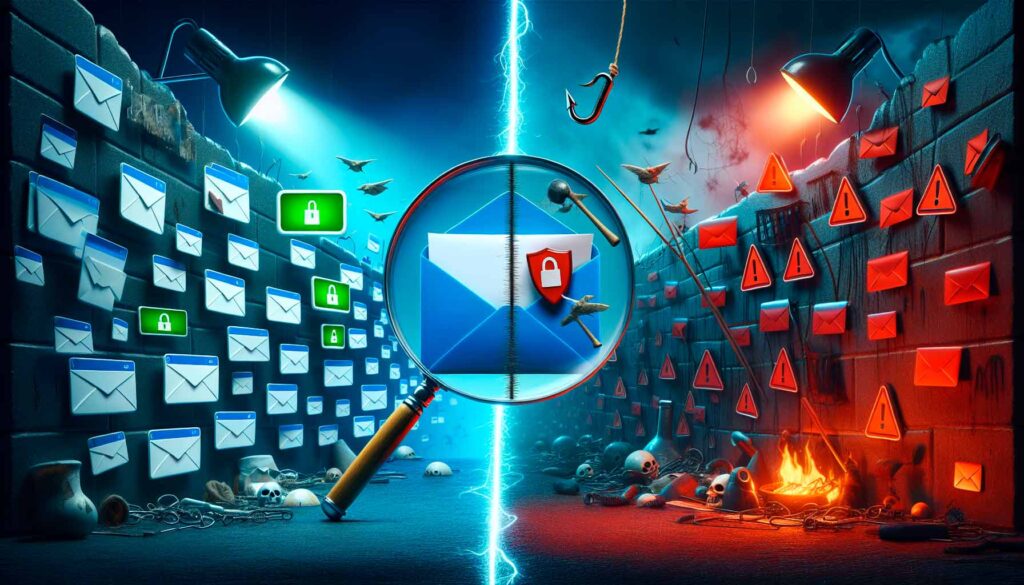In the digital age, the fake email detector has become an essential tool for online security. With the rise of email scams and phishing attacks, it is crucial to know how to verify the authenticity of the messages we receive. Malicious emails not only threaten our privacy, but can also have an impact on the cybersecurity of businesses and organizations. This article explores the common characteristics of fake emails and presents effective tools for checking emails online. In addition, practical steps are provided to protect against fraudulent emails and spoofing techniques such as spoofing. In the end, the reader will have the knowledge to identify and avoid malicious links, thus reducing the risk of data theft and improving their digital security.
Common characteristics of fake e-mails
Suspicious sender
One of the main warning signs when receiving an email is the sender. Cybercriminals often use addresses that mimic legitimate ones, but with minor variations. For example, they may change a letter or number to make the victim think it is something official. It is crucial to carefully check the sender’s domain to see if it really offers the service it claims. In many cases, fake e-mails have a strange address, with meaningless numbers and letters.
Grammatical and spelling errors
Fraudulent messages often contain grammatical and spelling errors that official entities would never include in a message to their customers. These mistakes are not accidental, but a deliberate tactic of the fraudsters. If an email has numerous typos, misspelled expressions or even nonsense characters, it is likely to be a phishing attempt. This strategy serves as a filter to detect people with lesser computer skills, who are more likely to fall into the trap.
Urgent requests or threats
Cybercriminals often play on immediacy to pressure their victims. A fake email may indicate that there is something wrong with the user’s account and that they should log in as soon as possible to resolve a bug. These urgent requests or threats seek to get the recipient to act without thinking by clicking on malicious links or providing sensitive information. It is important to be wary of any message that generates an excessive sense of urgency or requests immediate action, especially if it involves the disclosure of personal or financial data.
Tools to verify the authenticity of e-mails
SPF and DKIM checkers
To improve online security and protect against phishing and phishing, it is crucial to use tools that verify the authenticity of emails. SPF(Sender Policy Framework) and DKIM(DomainKeys Identified Mail) verifiers are essential in this regard. SPF is an authentication protocol that determines who can send emails from a specific domain. This helps prevent spoofing, a common technique in email scams. By implementing SPF, you significantly reduce the risk of someone sending malicious emails posing as a legitimate sender. On the other hand, DKIM adds an encrypted digital signature to the header of outgoing messages. Mail servers receiving these messages can decrypt this signature to verify that the content has not been modified during transmission. This not only protects against domain spoofing, but also guarantees the integrity of the message. These tools are essential to any cybersecurity strategy, as they help detect spoofed emails and prevent data theft. They also improve the deliverability of legitimate emails, preventing them from being marked as spam.
Link checking services
Another crucial tool in the fight against fake emails are link checking services. These services help identify suspicious URLs that could be part of phishing attempts or lead to malicious websites. Platforms such as VirusTotal allow you to scan suspicious links using multiple antivirus engines. This tool is especially useful for verifying the safety of links before clicking on them, thus reducing the risk of falling for scams or unintentionally downloading malware. Google Safe Browsing is another valuable tool that verifies URLs and determines whether a link is safe or has been reported as dangerous. This feature is integrated into popular browsers and helps protect users from malicious websites. In addition, there are services such as URLVoid that analyze the reputation of a website and report whether it has been flagged as malicious. These tools are essential to maintain online security and avoid falling victim to cyber-attacks through fake emails. By using these verification tools, users can significantly improve their ability to detect fake emails and protect themselves against online threats. It is important to remain vigilant and use these resources to ensure safe browsing and protect personal and business information.
Steps to protect yourself from fraudulent e-mails
Do not open suspicious attachments
One of the main ways cybercriminals spread malware is through fake email attachments. To protect yourself, it is crucial not to open attachments from unknown or suspicious senders. Even if the sender looks familiar, it is important to verify the authenticity of the message before opening any files. Users should be especially wary of file extensions such as .exe, .js, or documents that require macros to be enabled, as these may contain malicious code.
Avoid clicking on dubious links
Malicious links are another common tactic in fraudulent emails. To improve online security, it is essential not to click on suspicious links. Instead, it is recommended to type the legitimate URL directly into the browser. If a link needs to be verified, tools such as VirusTotal can be used to check its security before accessing it. In addition, it is important to be aware of techniques such as typosquatting, where cybercriminals use URLs similar to legitimate ones but with slight variations.
Verify legitimacy with the original source
When in doubt about the authenticity of an email, the best practice is to verify directly with the original source. This may involve contacting the company or person purporting to be the sender through an alternative means, such as a phone call or text message. It is important to remember that legitimate entities never request sensitive information or urgent payments via email. If a message generates suspicion, it is crucial not to act hastily and to take the time necessary to confirm its legitimacy.
Conclusion
In today’s digital world, the ability to identify fake emails has become an essential skill for online security. This article has explored the common characteristics of fraudulent emails, presenting effective tools for verifying email and its authenticity, and offering practical steps to protect yourself. By applying this knowledge, users can significantly improve their defense against email scams and phishing attacks. The fight against spoofed emails is an ongoing effort that requires being vigilant and staying informed about the latest techniques of cybercriminals. By combining awareness of warning signs, use of verification tools and adoption of safe practices, users can create a solid line of defense against online threats. This not only helps protect personal and financial information, but also contributes to a safer digital environment for everyone. ## FAQs
- How to determine if an e-mail is dangerous? To know if an email is safe, it is crucial to verify the sender’s domain, analyze the subject and content of the message, be wary of attachments, detect if tactics that generate urgency are used, avoid providing personal information, examine who is sending the email and verify the company mentioned on platforms such as LinkedIn.
- What characteristics should I look for to identify suspicious emails? To recognize a phishing email, it is important to check the message for signs such as misspelled phrases, poor quality logos or URLs that do not match the entity they claim to represent. If you accidentally click on a phishing link, avoid entering any personal information and close the page immediately.
- How can I check the authenticity of an e-mail? To verify an email, you can access the Email Verifier from the Correos website or from the Information Security area in the Customer Service portal. You must enter your email address and the code that appears at the bottom of the email received and then click CHECK.
- What are the signs that an email may be spam? Spam e-mails often come from addresses that do not make sense or look like scribbles, such as [email protected]. These addresses are a clear indication that the email is not legitimate.



